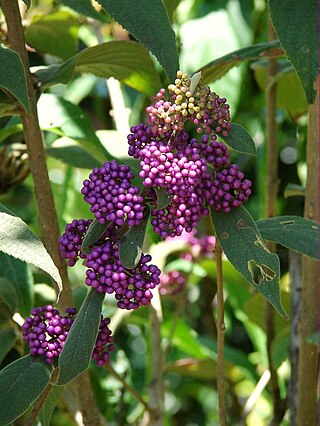
Callicarpa pedunculata is a shrub or small tree in the Lamiaceae family native to both Queensland and New South Wales.

Cuttsia viburnea is a shrub or bushy tree which has toothed leaves and panicles of white flowers, and that is endemic to eastern Australia. It is sometimes called silver-leaved cuttsia, and confusingly also native elderberry, honey bush or native hydrangea. C. viburnea is the only species assigned to the genus Cuttsia.
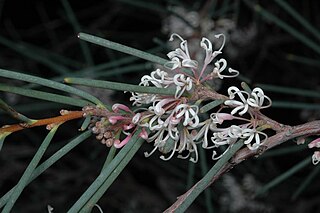
Hakea cycloptera, commonly known as elm-seed hakea, is a shrub in the family Proteaceae endemic to South Australia. It is a small spreading shrub with an abundance of pale pink or white flowers from December to August.

Achyranthes aspera is a species of plant in the family Amaranthaceae. It is distributed throughout the tropical world. It can be found in many places growing as an introduced species and a common weed. It is an invasive species in some areas, including many Pacific Islands environments.

Oxylobium arborescens, commonly known as the tall shaggy-pea, is a species of flowering shrub to small tree in the family Fabaceae and is endemic to south-eastern Australia. It has elliptic dark green leaves and yellow pea flowers.

Leionema phylicifolium, commonly known as alpine phebalium, is a shrub that is endemic to south-eastern Australia. It is a small shrub with green, smooth, leathery leaves and pale yellow flowers in spring.

Convolvulus erubescens, commonly known as blushing bindweed, or Australian bindweed, is a perennial herbaceous plant in the family Convolvulaceae that is endemic to Australia.

Hakea leucoptera, commonly known as silver needlewood, needle hakea, pin bush or water tree and as booldoobah in Koori language, is a shrub or small tree with rigid, cylindrical, sharply pointed leaves and white, cream-coloured or yellow flowers in late spring and early summer. It is widespread and common in central parts of the Australian mainland.

Dysoxylum arborescens, commonly known in Australia as Mossman mahogany, is a small tree in the mahogany family Meliaceae. It is native to rainforests of Malesia, Papuasia, Queensland and nearby islands.

Hakea fraseri, is a species of shrub or small tree commonly known as the corkwood oak, is a shrub in the family Proteaceae and is endemic to northern New South Wales. It has furrowed bark, pendulous foliage and creamy-white flowers in spring.

Acacia latzii, also known as Latz's wattle and Tjilpi wattle, is a shrubby tree of the genus Acacia. It is native to the Finke bioregion.
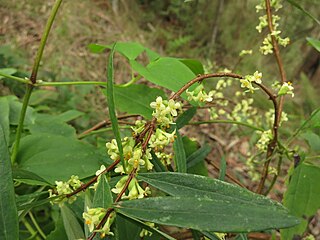
Pimelea axiflora, commonly known as bootlace bush, is a small shrub in the family Thymelaeaceae and is endemic to Australia. It is a small shrub with whitish flowers on mostly smooth stems.

Scaevola humifusa is a prostrate shrub in the family Goodeniaceae, native to Western Australia. It grows to a height of 0.01 to 0.5 m, and its white-cream/white-blue flowers may be seen from August to November or January.
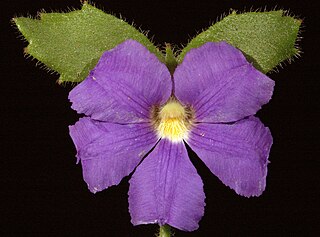
Scaevola pilosa, commonly known as the hairy fan-flower, is a perennial herb in the family Goodeniaceae. It is endemic to the southwest of Western Australia.
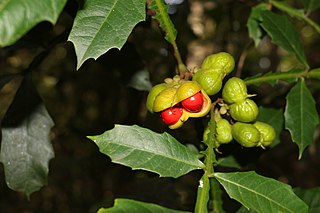
Harpullia alata, common name -winged tulip or wing-leaved tulip, is a tree in the family Sapindaceae, endemic to eastern Australia, and found from Brisbane, Queensland to Grafton, New South Wales.

Harpullia cupanioides is a plant in the Sapindaceae family found in south east Asia: in the Andaman Islands, Assam, Bangladesh, Borneo, Cambodia, Yunnan, Hainan, Jawa, Laos, the Lesser Sunda Islands, Malaysia, Myanmar, New Guinea, Nicobar Islands, the Philippines, the Solomon Islands, Thailand, and Vietnam.

Harpullia leichhardtii is a tree in the family Sapindaceae, endemic to the Northern Territory.

Leionema ralstonii, is a small shrub with angular, smooth branchlets and pale green flowers in winter. It is restricted to the south coast of New South Wales.

Myristica insipida, commonly known in Australia as Australian nutmeg, Queensland nutmeg or native nutmeg, is a small rainforest tree in the family Myristicaceae native to parts of Malesia, Papuasia and Australia. It is closely related to the commercially-important species of nutmeg, M. fragrans.

Austrostipa mollis, also known as the soft speargrass or supple speargrass is a robust, erect tufted perennial speargrass in the Poaceae family. It is native to Australia, and found in Western Australia, South Australia, Victoria, ACT and Tasmania.

























